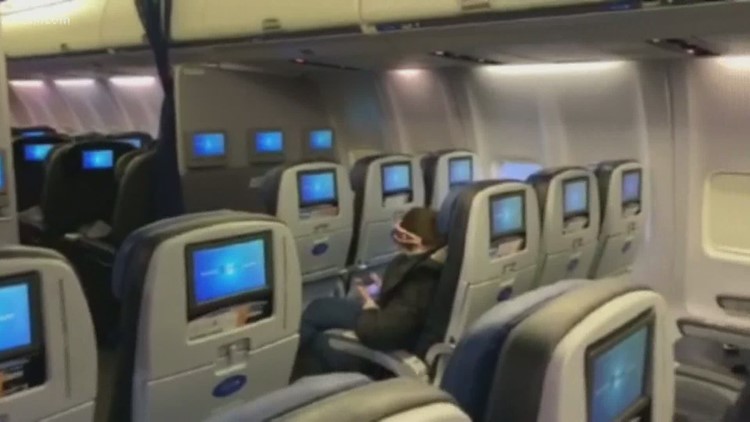ARIZONA, USA — This summer has seen a revamp in air travel for Americans, but not all people are as eager to board a flight as others.
A recent report has shown that air travel is a risky gamble for the more than 5.5 million people who have mobility disabilities and use wheelchairs in the United States.
The most recent Air Travel Consumer Report found that roughly 29 wheelchairs are either damaged or lost by airlines daily, for a total of 10,548 in 2019.
Wheelchair users could be left without their mobility and would have to pay hundreds or thousands of dollars in the event their wheelchair is broken or lost depending on the wheelchair model.
Here's the legal rights and safety tips that wheelchair users need to know before boarding a flight:
What happens if an airline damages my wheelchair?
Asim Dietrich, a staff attorney at the Arizona Center for Disability Law, said the first thing people with damaged wheelchairs should know is they are protected by federal law.
The Air Carrier Access Act is a federal law that prohibits commercial airlines from discriminating against passengers with disabilities. Additionally, the law requires modifications to policies and procedures be provided to accommodate any air traveler with a disability, including wheelchair users.
Part of that requirement is any medical equipment given to an airline must be returned in the same condition it was received.
"Basically, there is a requirement that damage not be done to wheelchairs or other medical equipment," Dietrich said. "And, if damage is done, it is the responsibility of the airline to pay for that damage based on the purchase price of the damaged parts."
Here are the steps someone should follow after their wheelchair was damaged:
- Alert an airline employee of the damages and ask what your options are for filing a complaint
- Ask to be directed to the airline's complaint resolution office. Every airline is required by law to have one of these offices in any airport the airline operates in
- File the complaint and have the damage repaired
- If the airline's complaint resolution office is not responsive or does not validate your claim that the damage was the responsibility of the airline, they must give you a written denial and provide you with other options to file a complaint with the Department of Transportation
"If the airline does not resolve your complaint to your satisfaction, then you can contact the Department of Transportation and file a formal complaint regarding the damage that occurred," Dietrich said.
Dietrich knows the difficulties of flying with a disability firsthand. Dietrich is a power wheelchair user and has been on a ventilator for the past 10 years.
Whenever he has flown, there was usually some amount of damage to his chair that had to be fixed or repaired. This, and the lack of accessibility for people with disabilities on airlines, is the reason Dietrich hasn't traveled by air in around five years.
Are there ways to prevent damage from happening to my wheelchair on airlines?
A three-time Paralympian in wheelchair tennis, Flagstaff native Kaitlyn Verfuerth has traveled around the world.
She has also had first-hand experience with having her independence and mobility taken away by an airline.
"This is how I get around," Verfuerth said. "To damage it would be like if someone took your legs and you couldn't go anywhere."
Verfuerth shared tips that she has learned on her many traveling for trying to keep her wheelchair safe, including:
- Always take the cushion off of chairs, if possible.
- Remove side guards from chairs and put them in the overhead compartment, if possible.
- If the chair is foldable, be sure to fold it up and get it compact.
- Take the wheels off and put them in a wheel bag or wheel holder.
- If you're traveling with two chairs, push it to the gate instead of checking it at the counter. Having the chair with you as much as possible will lessen the number of places the chair could get damaged.
Unfortunately, there is only so much a person can do to try and protect their wheelchair from damage.
Verfuerth followed all of these tips on one of her trips to Australia to play in tournaments. When she got off of the plane, her $5,000 competition wheelchair was mangled. She had to drop out of her first tournament and wait for a new chair to be delivered.
"You couldn't even get into the chair, it was so damaged," Verfuerth said. "I couldn't just jump into someone else's chair. It was custom-made. It was made for my body."
Why are wheelchairs damaged so often by airlines?
A lack of training and a lack of consistency between airports are the main reasons wheelchairs are damaged at such high rates, Verfuerth said.
She has seen airline workers drop her chair from high places and treat it like it was an everyday stroller on her travels. She said having workers understand just how important a wheelchair is to a person's wellbeing would be a step in the right direction for lowering wheelchair damages.
"I've seen people being in complete tears because they've shown up at their destination and their wheelchair was ruined," Verfuerth said. "Employees of the airline need to understand just how important this device is for us."
She said another solution could be designing airplanes to be more accessible and include other storage options for wheelchairs within the plane.
"If wheelchairs and mobility devices are getting damaged more frequently, there's something going on under the plane that maybe isn't working anymore or maybe they're overpacking it," she said.
Verfuerth will be boarding an airline on Aug. 25 and heading to Tokyo to compete in the 2020 Paralympic games. She hopes that her wheelchair will arrive in one piece.



